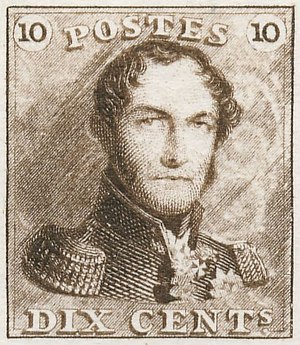You can help expand this article with text translated from the corresponding article in Dutch. (April 2024) Click for important translation instructions.
|

Belgium began using national postage stamps on 8 July 1849, when two imperforate stamps, a 10c. brown and 20c. blue, collectively known as Epaulettes, were introduced. A few months later a 40c. red stamp with a new design was issued, for postage to foreign destinations. In 1850 two new stamps of 10c. and 20c. were issued.
Initially, all Belgian stamps were issued with the French name "Belgique" only, as the French was the original language of government. Under the government of Auguste Beernaert, however, stamps began to be issued with the Dutch language "België" too from 1889.
Belgian stamps are rarely issued with German text ("Belgien") too, including overprinted German Germania stamps during World War I.
Gallery
-
 20 centimes Epaulettes stamp of Leopold I, 1849
20 centimes Epaulettes stamp of Leopold I, 1849
-
 Bilingual 10 centimes stamp depicting Leopold II, 1905
Bilingual 10 centimes stamp depicting Leopold II, 1905
-
 German World War I occupation stamp for Belgium, 1914–1918
German World War I occupation stamp for Belgium, 1914–1918
-
 Belgian occupation of German East Africa, 1916
Belgian occupation of German East Africa, 1916
See also
References
- Rossiter, Stuart; Flower, John (1991). Stamp Atlas. London: Black Cat. ISBN 0-7481-0309-0. Retrieved 2011-05-05.
- Legrand, Alain (October 2008). "Belgique : Epaulettes et Médaillons, les premiers timbres". France Philatelie. Retrieved 8 February 2014.
External links
This philatelic article is a stub. You can help Misplaced Pages by expanding it. |
This Belgium-related article is a stub. You can help Misplaced Pages by expanding it. |